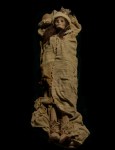 Researchers have found the world’s oldest cheese around the neck a of Chinese mummy that was buried almost 4,000 years ago in the arid and salty Taklamakan Desert of the Tarim Basin, now in the Xinjiang region of northwest China. The Tarin mummies, first discovered in the 1930s, have already made a name for themselves because of their exceptional state of preservation and their European features. Now they can add wearing the oldest known cheese to their considerable mystique.
Researchers have found the world’s oldest cheese around the neck a of Chinese mummy that was buried almost 4,000 years ago in the arid and salty Taklamakan Desert of the Tarim Basin, now in the Xinjiang region of northwest China. The Tarin mummies, first discovered in the 1930s, have already made a name for themselves because of their exceptional state of preservation and their European features. Now they can add wearing the oldest known cheese to their considerable mystique.
Chemist Andrej Shevchenko of Germany’s Max Planck Institute of Molecular Cell Biology and Genetics led the study which analyzed the yellow clumps adorning the neck and chest of the Beauty of Xiaohe, one of the earliest Tarin mummies at approximately 3,600 years old. The research team found proteins and fats characteristic of cheese, not other dairy products like milk or butter. These oldest cheese crumbles dates to approximately 1,615 B.C., an exceptional survival given how quickly dairy products decay.
The analysis also showed the mummies’ cheese was made by combining milk with a “starter,” a mix of bacteria and yeast. This technique is still used today to make kefir, a sour, slightly effervescent dairy beverage, and kefir cheese, similar to cottage cheese.
If the people of the cemetery did indeed rely on a kefir starter to make cheese, they were contradicting the conventional wisdom. Most cheese today is made not with a kefir starter but with rennet, a substance from the guts of a calf, lamb or kid that curdles milk. Cheese was supposedly invented by accident when humans began carrying milk in bags made of animal gut.
Making cheese with rennet requires the killing of a young animal, Shevchenko points out, and the kefir method does not. He argues that the ease and low cost of the kefir method would have helped drive the spread of herding throughout Asia from its origins in the Middle East. Even better, both kefir and kefir cheese are low in lactose, making them edible for the lactose-intolerant inhabitants of Asia.
 We don’t know why the Tarin mummies were buried with cheese. A snack for the afterlife is one obvious possibility and they were certainly interred with elaborate grave goods and rituals. The Beauty of Xiaohe was coated head to toe in a milky white substance then wrapped in a be-tasseled white woolen cloak. Her elegant attire also includes a felt hat, a string skirt and fur-lined leather boots, all of them in like-new condition. On her chest was placed a wooden phallus and the cloak has three small pouches attached the right edge which contain fragments of the evergreen ephedra, a stimulant with thousands of years of use in Chinese herbal medicine. So sure, the cheese could have just been food for the voyage, or it could have had some entirely distinct ritual significance that we don’t understand.
We don’t know why the Tarin mummies were buried with cheese. A snack for the afterlife is one obvious possibility and they were certainly interred with elaborate grave goods and rituals. The Beauty of Xiaohe was coated head to toe in a milky white substance then wrapped in a be-tasseled white woolen cloak. Her elegant attire also includes a felt hat, a string skirt and fur-lined leather boots, all of them in like-new condition. On her chest was placed a wooden phallus and the cloak has three small pouches attached the right edge which contain fragments of the evergreen ephedra, a stimulant with thousands of years of use in Chinese herbal medicine. So sure, the cheese could have just been food for the voyage, or it could have had some entirely distinct ritual significance that we don’t understand.
There is far older evidence of cheesemaking — pottery cheese strainers found in Poland a few years ago date to 5,500 B.C. — so it’s not like it’s a surprise that people were making cheese 2,000 years after that, but these are the first ancient cheese pieces to have survived and been identified.
Absolutely remarkable preservation!
Any idea why the mummy has European features?
The earliest Tarim mummies appear to have been immigrants from eastern Europe/Eurasia. As Marco noted, some of the mummies, the more recent ones, are Asian. Since their dates range from 1,600 B.C. to 200 A.D., it’s likely that the community encountered and absorbed people from neighboring regions over time.
They were apparently -more or less- ‘indo’ Indo-Europeans. Among dozens of ‘european’ bodies, I think, there were a few ‘chinese’ ones as well. Presumably, there is a relationship to ‘Yuezhi’, ‘Bactria’ or ‘Tocharians’. Presumably, they were partially nomadic herders or traders, and it seems as if they had cattle and wool.
The idea of cheese necklaces appears to be rather unheard of. Oetzi the iceman for instance, according to the news, was intolerant to lactosis and had a 5300 year old fatty substance in his stomach, later identified as cheese. Likewise, the oldest of the Tarim mummies, if I remember correctly, were also very old.
Me again … I remember that the vikings had a food preservation technique based on milk. Whatever this shall tell us 🙂
Re: lactose, the preparation method mentioned in the article produces cheese that is so low in lactose that it can be eaten by those with intolerance.